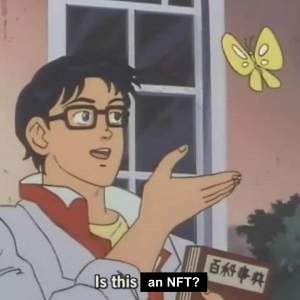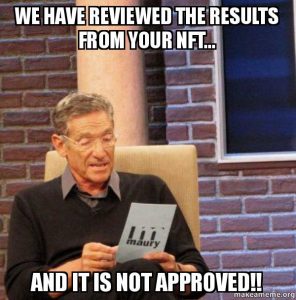Joseph Kemp

I can firmly admit this has been one of the most difficult topics I have ever had to cover before, both from the point of discussion and controversy analysis. NFTs, or Non-Fungible Tokens, are a topic that I’m sure most of you have seen in the news recently, or read in an article on a random google search, or maybe seen topping the twitter tags in recent weeks. It is also a very complex and hard to understand system of trading art “tokens,” and monetary improvements for digital content. On the other hand it’s a flawed system similar to that of the cryptocurrency bitcoin that in both accounts causes a problem of environmental risk and exacerbation of climate change.
NFTs seemingly were born from the critical analysis of prior systems of how artists are paid and how they make their money in life. In normal high-society art culture the moment a digital or physical artist sells a piece they no longer own the rights to it or any royalties in later upselling. So lets say an artist sells a piece at $16 they are paid for the piece and the buyer/collector takes it, as well as the overall ownership of the piece. The buyer can then in any amount of time place the piece within a private auction or list within a sale at an auction house and sell it for millions of dollars. None of this new profit will go to the artist who made it. They receive no royalties for their work whatsoever. NFTs have come into existence and more importantly come to the front of the artistic world for this reason among many others. A lot of digital artists think this is like a gateway to freedom from the very suffocating nature of current high-society art culture. It is a sad fact that artists in the modern world have to basically undersell themselves out to their buyers to gain any sort of notoriety, losing the profit margins that collectors have due to different social positioning and connections. The only solution is that the artist has to vy for exposure from their buyers by making websites, low balling prices, creating numerous social media points to gain any sort of traction as a freelance artist. This path is extremely difficult and not even truthfully lucrative for the artist attempting this process. Many artists will still work minimum wage jobs, dead-end commissions, or are manipulated by buyers to make any sort of progress towards a job that can pay for their lifestyles.
This process of freelance has always been present, the starving artist trope on social media or in cultural environments isn’t entirely inaccurate. Digital artists suffer this especially harshly, because of the lesser price of materials, and the ability to expedite work time. Many artists will be shortchanged on commissions, or will be labeled a sellout for pricing too high, or will have their overall image transitioned from one bad interaction with a buyer. The worst aspect is the stealing of their property, many graphic artists have had their work stolen from them by individuals, rich companies, or lost their right to their piece because of the usage of copyrighted material that fell within fair use. Essentially many freelance artists will end up being the spitting image of the starving artist trope , due to the unchanged conditions of the art market. NFTs to some is an attempt to circumvent this and get artists the credit they deserve and the sustainability of monetary income they need to fund their artistic pursuits.
The actual process of buying and selling NFTs is actually rather complicated so lets start there. As an artist, I create a piece that can be any file type, size, dimensions, or condition that I want. I then go onto a block-chain website (SuperRare, OpenSea, etc.) and make an account, read through their terms of service, and then enter the minting area of their site. In this area I can insert the file(s) that I want to be minted for me to receive a secured ownership of this piece. At this point, it is important to note, that should I want to make any changes to this piece or the content of the minting that I should do so now as the prices required to make changes later can charge pretty highly based on the “gas money” needed to update the blockchain with any changes if it is a uploaded piece. After inputting the proper information I pay a minting or “gas fee,” which is essentially a predetermined charge to help pay the data miners who run the blockchain, and add this post to the catalogue of NFTs on the blockchain. After paying the charge and waiting a bit the site will provide you with documentation stating you are now the owner of this piece and will receive 10% royalties with every sale of this piece after the original price is paid for, whatever you originally listed the piece for.
A few more specifics of this process include edition numbers which is another factor which can up the value of a piece. You can list the piece as a 1 of 1, 1 of 160, or even an infinite number. Essentially this means that when you sell the piece they pay the full price to the rightful owner as it was listed initially or as it was bought at an auction price sold by the artist. If the piece is listed to have multiple editions, then a higher price may occur for the 1/160 edition than the 100/160 edition. In the case of a 1/1 this basically creates scarcity as there is only one that can be bought from the current owner. In all of this it is important to remember that after it is sold the buyer is NOT buying the contractual ownership of this piece. They are buying the right to sell it from their own collection, essentially the artist still maintains partial ownership of the image and the artist will receive a 10% share of profits of any sales after the original trade. This process creates a possibility of continuous stable income for the artist, rather than receiving a one time payment for their piece they can now maintain partial ownership of their image regardless of who buys it or if people attempt to claim ownership.
Of course this system is still new and fragile, which is why there are around the clock data miners and admins following algorithms of trade deals, royalty payments, and the new additions to the blockchain. They are also in charge of removing any false claims from the system if people try to steal or wrongly claim ownership of a piece. This “new system” is actually somewhat older than one may think, sites like these were in existence back in 2017 and I’m not referring to bitcoin or its constituents. A site called Crypto Kitties was created back in 2017 by the same group who have designed the blockchain system for art NFTs. This project allowed them to test out the concept and lucrative profit value of a site of this nature.
Now sure, everything seems all fine and dandy, but what about the cost of this system, everything costs something right? You would be correct in thinking this. It has come out that not only is the cost of the upkeep for the blockchain incredibly expensive and difficult, but the environmental cost may even outweigh the benefits a system like this could have in the future. Now we have to acknowledge that it isn’t just the entire NFT system in general, it involves the actual overall currency system of Ethereum that is used to buy and sell the pieces. The way the algorithms are run constantly to check for proper monetary sales and properly protected authentication processes uses an insane amount of energy. If we follow the Ethereum Energy Index numbers the energy used by these systems is the equivalent of an entire home’s carbon footprint for 1.63 days! We have to remember that with all this data a massive amount of energy is used to maintain the blockchain. Not to mention the intense heat that the server farms or computer systems dedicated to the blockchain generate on average. This would mean to properly maintain this system they will need to organize data farms to run the algorithms constantly to maintain the balance of the blockchain. This would require massive servers, expensive freezer-like AC systems, that would mean a further expenditure of energy. Which is why many of the current data miners have their servers in cold locations to use natural temperatures to cool down the heat produced by the servers. There have been numerous posts related to the overall potential of blockchain technology, exhausting power supplies to power the system properly. The heat generated by the systems is also questionable, as it may have the potential to exacerbate the problems of climate change if not properly controlled. Even then the heat and energy costs generated with a rapidly expanding blockchain could be catastrophic.

Now, like most news of this nature, we have the major detractors mainly in the form of high society art collectors using fake numbers to scare the public with fear tactics. This is something that exists on both sides of the argument however, as there has been pro-crypto propaganda regarding the nature of blockchain power usage—mainly in regards to running on clean self-produced solar or hydroelectric power, though a lot of this is still unproven.
This all feels like it can be traced back to the anger of the high society art criticisms of NFTs. Overall the dialogue of art society comes off as an argument that has been recycled numerous times throughout art history—from the transition to modernism or social controversy of potentially “satanic” content. There is a history of the establishment hating new practices that may benefit them less or simply disliking them for having to adjust to a change in opinion. The insults thrown around seem more childish than effective means of stopping cryptocurrency, such as the degrading insults calling the art of the blockchain, “soulless,” “disgusting,” “lacking proper artistic interpretation,” etc. Of course the most often used insult is insulting them by saying that they need to crack open an art textbook and understand their legacy before they belong in an artistic world.
These arguments result from a variety of normal trends in viral topics. A lack of prior knowledge resulting in haphazard insults and conclusions that deface a potentially new and better system from previous bias. An overall resentment for change, any time someone’s lifestyle, methodology, or profit margin is threatened they will raise the alarm on social media to rally people against this new threat. The most important thing to acknowledge in all this is the age of this system. It is much younger than we think and it isn’t the first cryptocurrency out there (Bitcoin, et al.). We are not yet aware of how this system may change things. Maybe the system will make changes to lessen their environmental effects with blockchain tech, maybe high society art will start to desire these pieces and all this drama will be forgotten. In the end my conclusion is that this is something new, something different, unrefined, still evolving, and changing with the growing interest in its process. It will take time before we may understand the full scope of the system of NFTs and the effect it will have long term on artistic society.